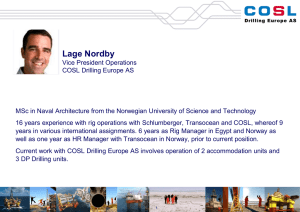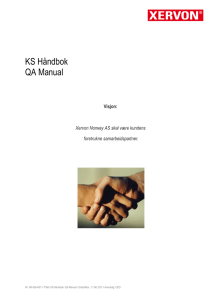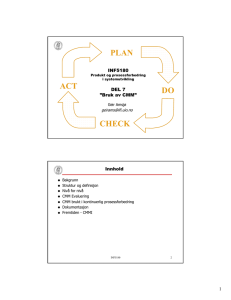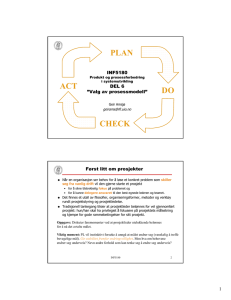Software Prosesser kapittel 2
advertisement
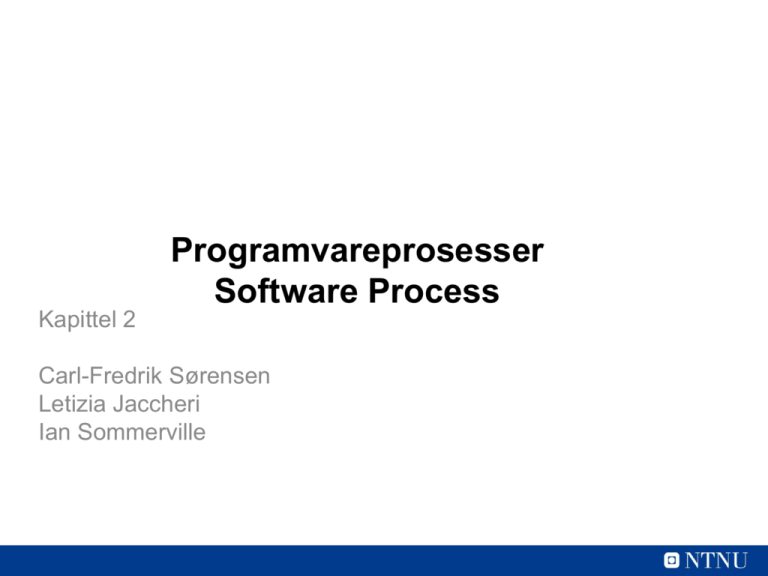
Programvareprosesser Software Process Kapittel 2 Carl-Fredrik Sørensen Letizia Jaccheri Ian Sommerville Programvareprosesser • Temaer som dekkes – – – – 2 Programvareprosesser og modeller for programvareprosesser Prosessaktiviteter Plandreven versus agile/smidig Modeller: Vannfallsmodellen, Rational Unified Process Programvareprosessen • En strukturert sett av aktiviteter som kreves for å utvikle programvare • Alle prosesser innholder: – Spesifikasjon - definere hva systemet skal gjøre – Design og gjennomføring - definere hvordan systemet organiseres og implementeres – Validering - kontrollere at den gjør hva kunden ønsker på en riktig måte – Evolution - forandre systemet i respons til endrede kundebehov. • Modell = abstrakt representasjon fra et synsvinkel – Tenk på Linux med 10 Millioner LOC 3 Prosess og model (hvem skal ut? ) Prosess Prosess OurToys Workshop Trondheim 2012 Prosess Modell http://hangingtogether.org/?p=390 The open library developer meeting 4 Den enkleste modellen spesifikasjon utvikling validering evolusjon 5 Prosess aktiviteter • Aktiviteter i en programvareprosess – Tekniske – Samarbeidende – Ledelse 6 Modeller for programvareprosesser • Aktiviteter – Spesifikasjon, design, utvikling, vedlikehold, men også designe et brukergrensesnitt, • Produkter som er utfallet av en prosess aktivitet – Test dokument, design dokument, • Roller som gjenspeiler ansvar for de menneskene som er involvert i prosessen – Arkitekt, systemeier, brukere, prosjektleder, utviklere, testere.. • Pre-og post som beskriver det som skal være sant før og etter en prosess aktivitet er vedtatt eller et produkt produsert – f.e. spesifikasjon signert 7 The waterfall model 8 8 Mer om vannfallsmodellen • Video Real Software Engineering by Glenn Vanderburg • https://www.youtube.com/watch?v=NP9AIUT9nos 51 min. • Managing the Development of Large Software Systems, Dr. Winston Royce, he was the first who described the Waterfall model for software development • SOFTWARE ENGINEERING Report on a conference sponsored by the NATO SCIENCE COMMITTEE Garmisch, Germany, 7th to 11th October 1968 9 Plan-drevne og smidige/agile prosesser • Plan-drevne prosesser er prosesser hvor alle prosessaktiviteter er planlagt på forhånd og fremgang måles mot denne planen. I smidige prosesser, er planlegging og utførelse inkrementell. Det er lettere å endre prosess og produkt for å reflektere endrede kravene fra kundene. Viktig!! Prøv å ha dette på minnet i gjesteforelesninger fra industrien 10 Inkrementell utvikling 11 Spesifikasjon • • Hvilke tjenester er nødvendig, og hva er begrensninger på systemets drift og utvikling. Prosess består av: – Feasibility study: er det teknisk og økonomisk mulig å bygge systemet? – Krav innhenting og analyse: hva krever interessenter fra systemet? – Kravspesifikasjon: definere kravene i detalj. – Kravvalidering: kontrollere gyldigheten av kravene spesifikasjon utvikling validering evolusjon Design og implementering av programvare • • • • • Fra spesifikasjon til et fungerende software system. Software design: Output - en programvarestruktur som realiserer spesifikasjonen Implementering: Output - en kjørbart program Design og implementering er nært beslektet og kan være sammenvevd Prosess består av: 1) Architectural design; 2) Interface design; 3) Component design; 4) Database design spesifikasjon utvikling validering evolusjon Programvarevalidering • Verifikasjon og validering (V & V) – mål er å vise at systemet oppfyller spesifikasjonen og oppfyller kravene (til kunden). 1. Review (statisk) 2. System testing (dynamisk) – Kjører systemet med testtilfeller fra spesifikasjonen av de virkelige data som skal behandles av systemet. Testing er den mest brukte V & V aktivitet. spesifikasjon utvikling validering evolusjon Testingnivåer • Komponent testing (skjer under utvikling) – Enkeltkomponenter testes uavhengig; – Komponenter kan være funksjoner eller objekter eller sammenhengende grupperinger av disse enhetene. • Systemtesting – Testing av systemet som helhet. Testing av viktige egenskaper/krav er spesielt viktig. – Akseptansetesting: Testing med kundedata for å kontrollere at systemet oppfyller kundens behov. 15 Software evolusjon/vedlikehold • Programvare er fleksibel (av natur) og kan endres • Når krav endres gjennom skiftende forretningsbehov/ omstendigheter, må programvaren som støtter virksomheten, også utvikle seg og endre. • avgrensning mellom utvikling og evolusjon (vedlikehold) blir stadig mindre relevant som færre og færre systemer er helt ny. spesifikasjon utvikling validering evolusjon Rational Unified Process iterativ og inkrementell Inception (Innledning): business case Elaboration (Utforming): problem domain + system architecture Construction (Bygging): system design, programming, testing Transition (Overgang): Produsere, Distribuere produktet til interessenter, Drive support for produktet. 17 Nøkkelpunkter • Programvareprosesser er aktivitetene involvert i å produsere et programvaresystem. Modeller av programvareprosesser er abstrakte representasjoner av disse prosessene. • Generelle prosessmodeller beskriver organiseringen av programvareprosessene. Eksempler av disse generelle modellene inkluderer vannfallsmodellen, inkrementell utvikling og gjenbruksorientert utvikling. 18 Nøkkelpunkter • Modeller og prosesser • Planlegging og inkrementell planlegging • Requirements engineering = Utvikle en spesifikasjon for en programvare/forretningsbehov. • Design og implementering = transformere en kravspesifikasjon til et kjørbart programvaresystem. • Programvarevalidering = sjekke at systemet er I overensstemmelse med spesifikasjonen og at det møter de virkelige behovene som brukere har av systemet. • Programvareevolusjon = Endre eksisterende programvaresystemer slik at de møter nye eller endrede krav. 19 Programvareprosesser Repetisjon og flere detaljer Software process models • The waterfall model – Plan-driven model. Separate and distinct phases of specification and development. • Incremental development – Specification, development and validation are interleaved. May be plan-driven or agile. • Reuse-oriented software engineering – The system is assembled from existing components. May be plan-driven or agile. 21 Waterfall model phases • There are separate identified phases in the waterfall model: – – – – – Requirements analysis and definition System and software design Implementation and unit testing Integration and system testing Operation and maintenance • The main drawback of the waterfall model is the difficulty of accommodating change after the process is underway. In principle, a phase has to be complete before moving onto the next phase. 22 Waterfall model problems • Inflexible partitioning of the project into distinct stages makes it difficult to respond to changing customer requirements. – Therefore, this model is only appropriate when the requirements are well-understood and changes will be fairly limited during the design process. – Few business systems have stable requirements. • The waterfall model is mostly used for large systems engineering projects where a system is developed at several sites. – In those circumstances, the plan-driven nature of the waterfall model helps coordinate the work. 23 Incremental development benefits • The cost of accommodating changing customer requirements is reduced. – The amount of analysis and documentation that has to be redone is much less than is required with the waterfall model. • It is easier to get customer feedback on the development work that has been done. – Customers can comment on demonstrations of the software and see how much has been implemented. • More rapid delivery and deployment of useful software to the customer is possible. – Customers are able to use and gain value from the software earlier than is possible with a waterfall process. 24 Incremental development problems • The process is not visible. – Managers need regular deliverables to measure progress. If systems are developed quickly, it is not cost-effective to produce documents that reflect every version of the system. • System structure tends to degrade as new increments are added. – Unless time and money is spent on refactoring to improve the software, regular change tends to corrupt its structure. Incorporating further software changes becomes increasingly difficult and costly. 25 Reuse-oriented software engineering • Based on systematic reuse where systems are integrated from existing components or COTS (Commercial-off-the-shelf) systems. • Process stages – – – – Component analysis; Requirements modification; System design with reuse; Development and integration. • Reuse is now the standard approach for building many types of business system – Reuse covered in more depth in Chapter 16. 26 Reuse-oriented software engineering 27 Reuse: Types of software component • Web services that are developed according to service standards and which are available for remote invocation. • Collections of objects that are developed as a package to be integrated with a component framework such as .NET or J2EE. • Stand-alone software systems (COTS) that are configured for use in a particular environment. 28 The requirements engineering process 29 A general model of the design process 30 Stages of testing Chapter 2 Software 31 31 Testing phases in a plan-driven software process 32 System evolution 33 Software prototyping • A prototype is an initial version of a system used to demonstrate concepts and try out design options. • A prototype can be used in: – The requirements engineering process to help with requirements elicitation and validation; – In design processes to explore options and develop a UI design; – In the testing process to run back-to-back tests. 34 Benefits of prototyping • • • • • 35 Improved system usability. A closer match to users’ real needs. Improved design quality. Improved maintainability. Reduced development effort. The process of prototype development 36 Prototype development • May be based on rapid prototyping languages or tools • May involve leaving out functionality – Prototype should focus on areas of the product that are not wellunderstood; – Error checking and recovery may not be included in the prototype; – Focus on functional rather than non-functional requirements such as reliability and security 37 Throw-away prototypes • Prototypes should be discarded after development as they are not a good basis for a production system: – It may be impossible to tune the system to meet non-functional requirements; – Prototypes are normally undocumented; – The prototype structure is usually degraded through rapid change; – The prototype probably will not meet normal organisational quality standards. 38 Incremental delivery 39 Incremental delivery advantages • Customer value can be delivered with each increment so system functionality is available earlier. • Early increments act as a prototype to help elicit requirements for later increments. • Lower risk of overall project failure. • The highest priority system services tend to receive the most testing. 40 Incremental delivery problems • Most systems require a set of basic facilities that are used by different parts of the system. – As requirements are not defined in detail until an increment is to be implemented, it can be hard to identify common facilities that are needed by all increments. • The essence of iterative processes is that the specification is developed in conjunction with the software. – However, this conflicts with the procurement model of many organizations, where the complete system specification is part of the system development contract. 41 Boehm’s spiral model • Process is represented as a spiral rather than as a sequence of activities with backtracking. • Each loop in the spiral represents a phase in the process. • No fixed phases such as specification or design - loops in the spiral are chosen depending on what is required. • Risks are explicitly assessed and resolved throughout the process. 42 Boehm’s spiral model of the software process 43 Spiral model sectors • Objective setting – Specific objectives for the phase are identified. • Risk assessment and reduction – Risks are assessed and activities put in place to reduce the key risks. • Development and validation – A development model for the system is chosen which can be any of the generic models. • Planning – The project is reviewed and the next phase of the spiral is planned. 44 Spiral model usage • Spiral model has been very influential in helping people think about iteration in software processes and introducing the risk-driven approach to development. • In practice, however, the model is rarely used as published for practical software development. 45 RUP iteration • In-phase iteration – Each phase is iterative with results developed incrementally. • Cross-phase iteration – As shown by the loop in the RUP model, the whole set of phases may be enacted incrementally. 46 Static workflows in the Rational Unified Process 47 Workflow Description Business modelling The business processes are modelled using business use cases. Requirements Actors who interact with the system are identified and use cases are developed to model the system requirements. Analysis and design A design model is created and documented using architectural models, component models, object models and sequence models. Implementation The components in the system are implemented and structured into implementation sub-systems. Automatic code generation from design models helps accelerate this process. Static workflows in the Rational Unified Process Workflow Description Testing Testing is an iterative process that is carried out in conjunction with implementation. System testing follows the completion of the implementation. Deployment A product release is created, distributed to users and installed in their workplace. Configuration and This supporting workflow managed changes to the system (see change management Chapter 25). 48 Project management This supporting workflow manages the system development (see Chapters 22 and 23). Environment This workflow is concerned with making appropriate software tools available to the software development team. RUP good practice • Develop software iteratively – Plan increments based on customer priorities and deliver highest priority increments first. • Manage requirements – Explicitly document customer requirements and keep track of changes to these requirements. • Use component-based architectures – Organize the system architecture as a set of reusable components. 49 RUP good practice • Visually model software – Use graphical UML models to present static and dynamic views of the software. • Verify software quality – Ensure that the software meet’s organizational quality standards. • Control changes to software – Manage software changes using a change management system and configuration management tools. 50 Key points • We have seen models for the single phases: requirements, design, validation, evolution?? • The Rational Unified Process is a generic process model that is organized into phases (inception, elaboration, construction and transition) but separates activities (requirements, analysis and design, etc.) from these phases. 51
